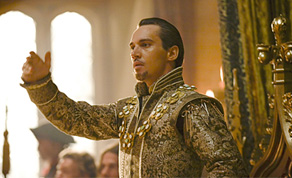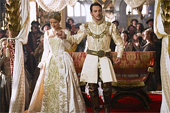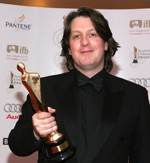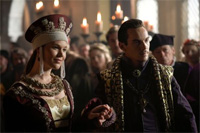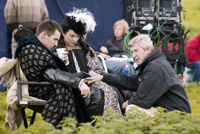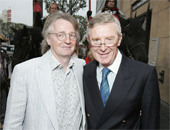| 19 April 2024 | The Irish Film & Television Network | |
 |
|
| And thus it has come to pass that the gargantuan operation that was the filming of ‘The Tudors’ has come to an end. The days of cavorting in the Wicklow hillsides, brooding at extravagant balls and seeing off wife after wife has come to an end for Jonathan Rhys Meyers’ Henry Tudor. The historical drama series from Showtime has introduced an image of unparalleled glamour and sexiness into the Tudor era. It chronicles the life and times of King Henry VIII, played by Jonathan Rhys Meyers, and sheds light on his veritable parade of wives and (sometimes questionable) political moves that changed the face of England, and beyond. The show, shot entirely in Ireland, has proved to be immensely popular with audiences around the world – when broadcast on BBC in August of this year the first episode of the penultimate series saw an average audience of 2.3 million tuning in. But how did it all start? What is it about Henry Tudor that inspired Michael Hirst to put pen to paper? Michael Hirst Well it was actually an accident that I started to write ‘The Tudors’, it was the same situation as ‘Elizabeth’ - someone approached me to write it and I did. But it was a very happy accident of course, they are just fantastically rich and dramatic episodes of history. As to my interest in that period of time, Henry and indeed Elizabeth are very iconic English monarchs and more seemed to happen within English society and religious life during their reigns than in any other period during English history. After all, we stopped being a catholic country and became a protestant country in a very short period of time and certainly writing The Tudors - which is like thirty eight hours of TV - I was never short of material, I never had to scratch my head and think “Where do I go now?” because there was always something very, very dramatic happening. I love historical material anyway and this time is so rich and fascinating. ‘The Tudors’ episodes have been helmed by several directors. Talent such as Emmy winner Dearbhla Walsh (Little Dorrit), Jeremy Podeswa (The Five Senses) and Steve Shill (Dexter) joined Ciarán Donnelly in bring Michael Hirst’s vision to life. Donnelly, who won an Irish Film & Television Award in 2009 for his work on the series, describes how the concept of ‘The Tudors’ was explained firstly to Michael Hirst and subsequently passed on: Ciarán Donnelly The vision or idea of the series is very, very simple. The idea of the series, as it was pitched to Michael, is ‘The West Wing in the Tudor era’ so essentially you’ve got a president or a king and a number of people who are or are not on his side, politically speaking. The power that this man has is God-like, he has the power of life over death. And that was basically it – it’s a court; a political court, a social court, a gossip court. . . it’s essentially a precinct. Armed with this vision of ‘The Tudors’ cast and crew set to work in May 2006. At this point Michael harboured hopes that the show would run for four series but, as with every pilot, the writer knew that nothing was certain: MH: I always wanted it to go the four series, because that was how it had panned out in my head, but I absolutely never knew that we were going to go that far. Sometimes you can’t tell beforehand, you don’t know and all you can do is hope that you are writing something that will connect with people but you can’t know that it is going to happen. And then when you slowly become aware that it is happening then you feel humbled and moved. There is still a kind of magic to it. As a writer you are just stuck in a room somewhere writing this stuff on your own and you don’t know whether it is going to connect and it’s wonderful that ‘The Tudors’ has. So, what has been the secret to success of ‘The Tudors’? Michael has a theory: MH: There are a number of things at play. I think the show works at a soap opera level and I think people get embedded in the characters simply through wanting to know what happens next. I think in America it’s called ‘Addicted to Television’ - once you start watching it you can’t stop because you are desperate to know what happens and, of course, with ‘The Tudors’ I think the audiences is often involved in the story, in the characters and, as I say, the production values were extremely high and it seemed to work across cultures, ages and sexes – although I would say probably the biggest audience for the Tudors is women. I think another reason why these things have worked so well is because I never looked at the show from the outside in - I didn’t look at Henry as an iconic being, I looked at the show from the point of view of the characters – human beings in extreme situations and then wondered how they would react, as human beings, in those situations and I think that people connect with that. I have taken these people out of the museum and that is the simplest way of putting it. Director Ciarán Donnelly has further musings on the subject, describing how different directors brought their creativity to the series. CD: I think each director brought new elements to the show. We are all given a script which we have to make work. We want to try and put our stamp on it, keep it visually interesting and try to get scenes out of the sets and onto locations as much as we can so there is a constant discussion going on which means everyone is on the same wavelength. You are not introducing a system, as such, but what individual directors have been able to do on this show (unlike a lot of US TV shows) is to put our own stamp on it in terms of how we would visualise things and I think it is only fair to say that you might spot a Dearbhla episode being different to a Ciarán episode which in turn is different to a Jeremy Podeswa episode. If you’re familiar with the show you can probably spot the changes, which adds an extra layer to the show. Furthermore, I think the directors are well fitted to their episodes, for example in the third series the first four episodes are about a rebellion against King Henry which is called The Pilgrim of Grace. That was a four hour story line and they needed a director who was visually cinematic in television terms, could handle action, some battle scenes and things like that as well as a strong character actors’ director – they chose me for that. Then there would perhaps be another director who wouldn’t have been appropriate for that but would have been more character led. What they do is they say “This director fits this storyline”, that is really how they divide it up and it works the best, obviously. ‘The Tudors’ has come under fire somewhat for giving audiences a ‘Hollywood’ version of the historic events shown in the series. So what was more important to the team – historic accuracy or aesthetically pleasing television and scandalous storylines? MH: Well, I am first and foremost a dramatist - I was commissioned in the case of ‘The Tudors’ to write dramas not historical biographies or historical programmes. If I had been asked to write historical documentaries I would have gone about it in a different way. In terms of showing Tudor life, the show is remarkably true to history as reported by historians (but you can’t always trust historians because they contradict each other anyway). I am often criticised by people (who honestly don’t know the history themselves) and one historian in particular who has attacked me consistently, and though I think it is drama before all else ‘The Tudors’ is remarkably true to the general thrust of history. But, there’s more than just that - I know for a fact because I get a lot of feedback that the show encourages people to go and look at the history books themselves, it galvanises the study of history and not just here but in America and all over the world. ‘The Tudors’ is now being shown in over 70 countries so many, many millions of people are watching it and absorbed by it and, as I say, it is encouraging the study of history. Now, although that is not one of my objectives it has been one of the results and I am extremely pleased. And when it came to the locations used in the four series – was historical accuracy paramount or did logistics rule? Locations Manager Edmund Samson explains: Edmund Sampson: Time and accessibility are huge considerations but primarily it is the aesthetics that I look for. If (production designer) Tom Conroy and his team can achieve something beautiful within that environment we primarily look at that and then after that we service it to be historically correct. The show’s audiences have been privy to King Henry strolling around the grounds of Christ Church, riding across the hills of Wicklow and have seen Dublin Castle transformed into the Vatican City. Did Michael have Ireland in mind when he wrote ‘The Tudors’? MH No, I was developing the series with Showtime and initially I didn’t have any clue of where they were thinking of shooting it. They then revealed they were going to shoot it in Ireland, partly because of the tax breaks and also because they had a relationship with Morgan O’Sullivan at Ardmore. So I met Morgan for the first time then and we are really the best of friends now, very close. It has been an incredible journey for me with him, with the whole crew and set-up in Ireland was fantastic, I’ll miss that yearly experience probably more then anything else. Just going over to Ireland for three or four months every year has been an extraordinary and wonderful experience for me and the crew, I don’t think you would get a crew like that in any other country, certainly not in America or England. They were absolutely wonderful and professional and I just had a ball. And did location manager Edmund Sampson have as good of a time finding the required locations? There were two elements that worked together when we were considering our various locations: a) aesthetically how they worked for Tom Conroy and b) practically - if we could film them, whether they were nearby and accessible etc. And that’s why the close-knit environment of Ardmore, the rest of Wicklow and Dublin was such a successful location and position for us to be in because in a very small area we had a series of fantastic locations that enabled us to achieve the award winning look of ‘The Tudors’. You can hop from an army on the rise marching over the hill to Henry walking through his gardens with whichever wife he was with at the time and then you hop into Dublin and you have amazing locations like Christ Church Cathedral, Dublin Castle, Kilmainham Jail, the Royal Hospital in Kilmainham, Drimnagh Castle the Phoenix Park and all these things are so close together - which obviously helped us achieve the huge undertaking in a very brief period of time. The true beauty of the environment we had to shoot in - Dublin, Ardmore and Wicklow - is that, within a very small space, you have such a diverse and wealth of beautiful locations that are suitable for the portrayal of any environment and any period. Ciarán Donnelly very much concurred with these sentiments and saw to it that he made use of all the locations he could: CD: One of the only things Showtime wanted was that we kept the camera moving and that ‘The Tudors’ wouldn’t be a group of talking heads in the same room for long periods of time. So you keep the camera moving, come up with interesting blocking, do your best to remove scenes from interior set locations to the outside world which, of course, is the whole point of television. With Ardmore in Bray, Wicklow, just being down the road and with Christ Church in town and all the other stunning locations that we have been able to shoot in being so close, it is up to the director to get the production out and about and fight for that. When you look at the first episodes of series three you will see absolutely that this happened, it is a hugely exterior show. Also, in episode nine and ten of the fourth series you’ll see that I get out quite a lot. I think what you can do every once in a while is say “instead of shooting these (what we call pretty council meeting scenes) on a certain set let’s move that out to the Royal Chapel in Dublin Castle” which we do and it’s much more beautiful and it feels different. Now clearly nobody loved me for it from a cost point of view but at the end of the day the audience loved and that is the most important thing. And did any of the locations used filming The Tudors specifically stand out? ES I couldn’t pick out one because we all had such a good relationship with each of the locations. That said I think the locations we picked for season four, when they come out on television next year, will all look stunning and I think some of the scenes we hadn’t achieved before - because they weren’t in the script, or for whatever reason - will now appear because the fourth season allowed us to do so much – and I mean that for all the elements like the costumes, set decorating, the design, special effects and the visual effect, I think this fourth series is going to look particularly amazing on screen. Was the use of a green screen instead of real locations ever considered to cut down on cost? ES: I think that in this era the audience is very savvy and I think when you have those large elements and hugely impressive buildings available it’s a crime not to use them. I don’t think you could ever recreate places like Dublin Castle, Christ Church Cathedral or any physical element like that. I think that’s obvious when you are shooting inside there and I think just the tangibility of it is what sells it. On a slight aside, does Edmund feel that Irish location managers have a responsibility to promote the use of Irish locations whenever possible? ES: I think that responsibility rests on the location manager when producers or other people involved are undecided or considering whether their particular project is going to be achievable in Ireland and I think the huge responsibility of the location manager is to put a package together to sell Ireland to foreign investors and producers when they arrive over. I think that is where our responsibility is and it is a big responsibility. The very gratifying thing is that Showtime went from going to looking at locations in Canada, New York and Los Angeles before coming over and settling on Dublin and believing that it could be achieved in Dublin. ‘The ‘Tudors’ series started off as we were still enjoying carefree Celtic Tiger days, did any of the team experience a tightening of their respective belts for the last two series? ES: Well, ultimately our industry is not unlike any other industry and there are restrictions when you are renting or hiring goods. There is more competitiveness out there now and people are reducing their prices so when going to places to hire or rent there is more negotiation there, you phone around and you get the best price and those prices have come down. That said, over the last four years we have built up a relationship with our location owners and the likes of the OPW and various county councils and it’s worked very well. The fees that have been negotiated have always been mutually acceptable. MH: Funnily enough I think it was the collapse of the dollar in the third series affected us more in that, as a result, we could only do eight episodes rather than ten. Apart from that we haven’t been affected by the Irish recession in the sense that we were getting funding from America. The show was a Canadian / Irish co-production so we didn’t have all our eggs in one basket, but having said that, as it turned out we were fantastically lucky to start when we did. I felt that what we have done is give value for money. All the money that is spent on The Tudors is as they say “up there on the screen” and it will and is bringing its rewards and profits. I think even now it is in profit which is very unusual for a series that is still going. Let me also say this - I was conscious that we were bringing employment and opportunity to quite a large number of people in Ireland and I think it will be missed because it is not just the three hundred or so people who were directly working on it, the actors which we took off the Irish stage but of course it’s the knock on effect on people like the drivers, the hotels and the restaurants. Someone told me that there were over four hundred and fifty speaking parts in The Tudors, many of whom were Irish. It will definitely be felt, it was a little industry in the end touching many parts of life in Ireland. This sense of loss is, no doubt, currently reverberating through the show’s cast and crew, the series was a huge boost to the Irish industry and provided work for hundreds of Irish people. With such a large cast and crew involved in this ‘little industry’ there were surely some difficulties encountered as production went on? For director Ciaran Donnelly: Executions are, logistically, very tricky, I have done quite a few of those and because there are things involved like axes and people getting their heads cut off and usually you have a big crowd, big visual effects and tricky material and those days can be logistically tricky and its all down to the planning. You have to plan it shot by shot and storyboard it, everybody needs to know exactly what it is you are trying to achieve in each shot. There was never a time when I thought “this is impossible”. Usually the biggest problem is time. Executions, bad weather and time. But it is apparent that the positive aspects of working on ‘The Tudors’ far outweighed working in Ireland’s less-than-tropical climate. Michael Hirst has fond, if somewhat alternative, memories of the series’ shoot: Michael Hirst: Many highlights and of many kinds. One of those is the flat or house in Dalkey that the production rented me during each shoot, the building would always be on the sea so when I think of ‘The Tudors’ I always think of the sea. There is very little sea in the production but I have spent many, many hours sitting at a desk looking out over the ocean in Dalkey and dreaming of characters and their lives. I suppose the camaraderie of the crew and cast was continuous and is still continuing - it was wonderful, the craic and the laughter. And of course many, many great scenes with wonderful performances. I also got to see my life come full circle; in the third series the story was partly about a rebellion against Henry’s reign, called the Pilgrimage of Grace, and this started in Yorkshire which is were I come from. We shot a lot up in Sally’s Gap and Wicklow mountains to portray parts of Yorkshire and I would go up to the top of the mountains and think “Yes, this looks like part of my childhood, this will pass for Yorkshire, this is great”. So for me it was like coming home, it connected me to the two landscapes in a very deep way and I am glad to say that I slightly regard myself as an honorary Irishman now. As someone said “You can be Irish Michael because you are the only English man we know who cries”. It was really interesting how he finished the series because Michael wrote a scene and I looked at it and said “Can we do this instead, it kind of means the same thing but it’s different”. He looked at it and said “Yes, ok” and we filmed all that in the last few days and we all just had our socks blown off by the visual aspects of it - by how Johnny was playing in it. It definitely ended on a high from our point of view. ES: I think the highlight is when you have gone through all the discussions with all the various departments and everybody walks in on the morning of the shoot and sees what they have talked about suddenly come to life in front of them and to see the production come together in such a successful fashion that ‘The Tudors’ has been over the last four years. The most gratifying aspect of the whole season for us all is that the fact that this has not been presented to anybody previously and it is something that hasn’t been achieved previously in Ireland and now, through all departments and through the assistance of the location owners, the Gardaí and the Fingal County Council we have produced a product that is a mammoth hit internationally and has recognised Irish talent, Irish actors, Irish locations and Irish crew on the international scale. We are recognised now as a top professional crew that can achieve high end coached drama as well as feature film drama. CD: Yes, it’s an unusual thing to have to do. It is quite a mixed bag of emotions I suppose. I don’t think people are sad about the characters as such but I think when you have been working on a show like this with the same crew and more or less the same cast over four years it’s kind of the end of a family, the Tudor family and an Irish film crew family. People do become very connected and bonded over that period of time when they work so closely together MH: It is very difficult. It was tremendously difficult for me to write the last episode to say goodbye to a lot of the characters when they died. They have been my companions, a lot of them for more than four years about six years, and it’s always been a great thrill, a pleasure to come to my study here every morning and find out what they have been up to and what they are doing. They talk to me - I don’t mean that I am mad and they literally talk to me – but they are very real in my head and it is difficult to have that stop now. I am going through some sort of withdrawal symptoms now, it is very difficult for me to live in the world without them but of course I have to pass onto new things but this has gone on for years so I do dream about them as well as think about them on a daily basis. What it means, essentially, is that they are fantastically real to me. MH: We are working on Camelot which we hope to do in more or less the same way at Ardmore and if we get our own way have the same crew and set up. It will be a larger production simply because of the scale piece and I have written the first few episodes, and we have started to cast. Nothing is set in stone yet but we are quietly confident of doing it. It has been a project I have wanted to do as far as I can remember. In fact when I was a boy in rural Yorkshire walking to school something I always wanted to see was a knight in armour coming round a bend so I might get to see that finally. Morgan and I are constantly plotting, inspiring, thinking and dreaming of the things we can do because we have liked it so much. It’s not just the success of ‘The Tudors’ it is something deeper, something more. Relationships in the film industry are usually simply ruthless and temporary but the people at the centre of ‘The Tudors’ production have made real and lasting friendships. It was an experience that we would all like to repeat as soon as we possible so that is what Morgan and I are working towards. |
||||||||||||||||||||||||||||||||||||||||||
Contact Us | Advertise | Copyright | Terms & Conditions | Security & Privacy | RSS Feed | Twitter
|
||||||||||||||||||||||||||||||||||||||||||
